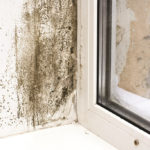 Condensation is an issue that anyone involved with housing management, maintenance and building will be all too familiar with, as a number of long-term factors ensure it remains a critical issue. However, as Paul Harrington, Head of Residential Sales at Homevent (Elta Fans Residential Division) explains, recent events mean that this years’ condensation season could be worse than ever.
Condensation is an issue that anyone involved with housing management, maintenance and building will be all too familiar with, as a number of long-term factors ensure it remains a critical issue. However, as Paul Harrington, Head of Residential Sales at Homevent (Elta Fans Residential Division) explains, recent events mean that this years’ condensation season could be worse than ever.
Condensation typically occurs during the colder months of the year, caused by warm air inside the home rising, and then suddenly cooling as it comes into contact with colder walls and windows. This forms water droplets and, in poorly ventilated rooms, can lead to a type of mould, which can cause serious health issues, as well as having a damaging effect on the building.
The English Social Housing Survey (2018-2019) highlighted that there are almost a million households in the country suffering from issues of condensation and mould. This is a concerning figure that demonstrates the extent of the problem, yet it will come as little surprise to many social housing landlords who face a constant battle to keep condensation at bay.
The reasons for its prevalence, particularly in the social housing sector, are numerous. Many are long-term factors that are often linked as much with tenant behaviour as they are with structural issues. However, there have been a couple of key changes in the past year that mean significant action must be taken to prevent instances of condensation from increasing significantly.
Occupant behaviour
One of the most challenging aspects of tackling condensation within social housing is that of tenant behaviour. It is something that is largely out of a landlord’s control, and relates to moisture-producing activities within a household. This includes drying clothes or running a bath, things, which can seem perfectly normal to do in a home, but because they produce so much moisture can cause problems if the property is not ventilated properly.
This issue is compounded when tenants on low incomes cannot afford to turn their heating on. Where opening a window might help to naturally ventilate a room when drying clothes, this is not an option for those living in fuel poverty, and low-income households become a hotbed for condensation.
While landlords have little control over this type of behaviour, it is important that they are aware of the issues it can cause. Whether it is implementing a more effective ventilation strategy, or speaking with tenants to educate them on the dangers of condensation, landlords should ensure they address the challenges associated with indoor moisture production.
Homes Act
The Homes (Fitness for Human Habitation) Act 2018 means that landlords across all rented properties have an obligation to ensure their property is safe and healthy for tenants — which includes routinely checking for, and protecting against, condensation and mould. 2020 saw the Act updated to cover all rented properties, increasing the focus on conditions across the entire sector.
Adopting a ‘prevention is better than cure’ approach will enable landlords to avoid falling foul of the Homes Act, tackling the root causes of condensation before they become a major issue. A strategic assessment of ventilation strategies within a house is critical, taking into account a range of factors including tenant behaviour and occupancy levels.
Green Homes Grant
Under the Green Homes Grant, which goes live at the end of September, families will receive vouchers of up to £5,000 for energy-saving changes to their home. Crucially, this includes insulation, and while this is a positive move from a heat-loss and carbon emissions perspective, it could have a damaging knock-on effect for indoor air quality.
Over the past few decades, increasingly well-insulated properties have caused headaches for those tasked with delivering effective ventilation. It reduces the amount of air that flows in and out of a property, which reduces natural ventilation to the point where it creates an environment conducive to mould growth and increased pollutant levels.
Clearly, this new scheme will have a number of benefits, not least in addressing the issue of fuel poverty we touched upon earlier. However, this cannot be allowed to cause other issues down the line, which it will undoubtedly do if ventilation is not considered. The provision of a low energy mechanical ventilation system can complement these thermal improvements, and landlords should consider the overall health of a property when undertaking home improvements.
Increased home occupancy
The lockdown that was brought into effect in reaction to the Covid-19 pandemic has affected all aspects of our lives, with many spending more time in their home than ever before. This is likely to continue in the short-term, with households either growing in size, or occupants spending more time indoors than in previous years.
Even as we transition out of lockdown, there has been a marked change in attitudes towards working from home, with 74% of those asked in a recent survey saying they would prefer to continue working remotely. This means that homes are likely to be occupied during the day where previously they might not have been, which has a big impact on the level of ventilation required.
Increased occupancy levels invariably mean higher rates of moisture production, and therefore instances of condensation and mould. If working from home is likely to become more common moving forward, it is critical that landlords adapt ventilation strategies accordingly.
Combating condensation
Condensation has always been an issue in rented and social housing, and as we have outlined here, it is likely to worsen in the coming months. There are a number of solutions available to landlords when it comes to improving ventilation, which is most effective when a case-by-case approach is taken. To outline some of the options available to combating condensation, Elta Fans has produced a comprehensive guide, which can be viewed here.









